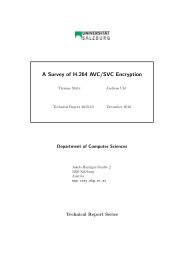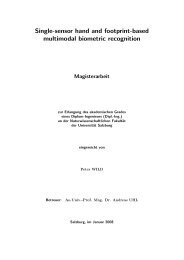Pit Pattern Classification in Colonoscopy using Wavelets - WaveLab
Pit Pattern Classification in Colonoscopy using Wavelets - WaveLab
Pit Pattern Classification in Colonoscopy using Wavelets - WaveLab
Create successful ePaper yourself
Turn your PDF publications into a flip-book with our unique Google optimized e-Paper software.
4.4 <strong>Classification</strong><br />
decomposition trees. Therefore D is<br />
⎛<br />
D =<br />
⎜<br />
⎝<br />
0 d D11 ,D 12<br />
. . . d D11 ,D 1n<br />
. . . d D11 ,D C1<br />
. . . d D11 ,D Cn<br />
d D12 ,D 11<br />
0 . . . d D12 ,D 1n<br />
. . . d D12 ,D C1<br />
. . .<br />
.<br />
. . . . . . . .<br />
d D12 ,D Cn<br />
.<br />
d D1n ,D 11<br />
d D1n ,D 12<br />
. . . 0 . . . d D1n ,D C1<br />
. . .<br />
.<br />
. . . . .. . .<br />
d D1n ,D Cn<br />
.<br />
d DC1 ,D 11<br />
d DC1 ,D 12<br />
. . . d DC1 ,D 1n<br />
. . . 0 . . .<br />
.<br />
. . . . . . ..<br />
d DC1 ,D Cn<br />
.<br />
d DCn ,D 11<br />
d DCn ,D 12<br />
. . . d DCn ,D 1n<br />
. . . d DCn ,D C1<br />
. . . 0<br />
⎞<br />
⎟<br />
⎠<br />
where d Dij ,D kl<br />
now is the euclidean distance between the j-th image (distance vector) of<br />
class i and the l-th image (distance vector) of class k.<br />
Then similar to section 4.3.4, the centroids for all classes can be calculated. But <strong>in</strong> this<br />
approach the centroids are not decomposition trees anymore, but distance vectors. Thus, a<br />
centroid <strong>in</strong> this context is the distance vector of the image of class c, which has the smallest<br />
average euclidean distance to all other distance vectors of class c.<br />
Once the centroids have been calculated, the classification is done by first decompos<strong>in</strong>g<br />
an arbitrary test image I T <strong>in</strong>to the accord<strong>in</strong>g decomposition tree T T us<strong>in</strong>g the best-basis algorithm.<br />
Then the distance vector D T between the decomposition tree T T and the LDB tree<br />
T LDB is calculated. Hav<strong>in</strong>g calculated the distance vector, the class of the closest centroid<br />
can be assigned to the image T T , where the closest centroid is the one hav<strong>in</strong>g the smallest<br />
euclidean distance to D T .<br />
4.4 <strong>Classification</strong><br />
In this section we present the two concrete classifiers used <strong>in</strong> this thesis - namely the k-<br />
nearest neighbour classifier and the support vector mach<strong>in</strong>es.<br />
4.4.1 K-nearest neighbours (k-NN)<br />
The k-NN classifier (see section 3.3.1) was chosen due to its simplicity when it comes to<br />
implementation. And yet this classifier already delivers promis<strong>in</strong>g results.<br />
To apply the k-NN classifier to the data first of all the feature vector F α for the image I α to<br />
classify is calculated. Then the k-NN algorithm searches for the k tra<strong>in</strong><strong>in</strong>g images for which<br />
the respective feature vectors have the smallest distances to F α accord<strong>in</strong>g to some distance<br />
function such as the euclidean distance. The class label which is represented most among<br />
these k images is then assigned to the image I α .<br />
57








